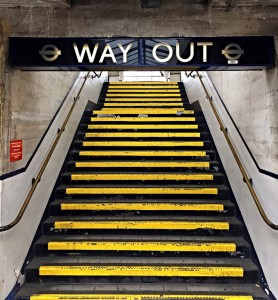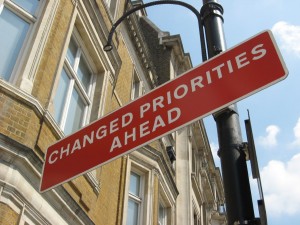
Depression is a major cause of distress and disability (Whiteford, HA. et al, 2013), and accounts for many appointments in primary care. Cognitive behaviour therapy (CBT) is an effective psychological therapy for depression, and many patients and clinicians are keen to use CBT either in isolation or in combination with antidepressant therapy. However, there are far too few therapists to meet the demand for CBT and the waiting lists are unacceptably high. One enticing solution to the therapist shortage is to have CBT delivered by a computer programme. This is also an attractive option given the financial burden the NHS is experiencing.
Computerised CBT (cCBT) forms part of the ‘stepped care’ model of depression treatment in primary care, and its use is suggested for people with mild to moderate depression (NICE, 2009). Several internet-based programmes are available, including programmes that are free to access and others that are commercially marketed. These programmes have been shown to work in developer-led trials (e.g. Proudfoot, J. et al, 2003).
The aim of the REEACT trial (Randomised Evaluation of the Effectiveness and Acceptability of Computerised Therapy), published last week in the BMJ, was to independently assess the acceptability and effectiveness of cCBT versus usual GP care for depression in adults, and the relative effectiveness of a package that is free to access versus one that is commercially marketed.

NICE recommend cCBT as part of a stepped care model of depression treatment in primary care.
Methods
The REEACT trial was conducted at 83 GP practices. Participants with depression were randomised to receive usual GP care, the freely available ‘MoodGYM’ (6 sessions) or the commercially available ‘Beating the Blues’ (8 sessions). Participants in the cCBT groups also received weekly telephone support. It was a pragmatic trial with no restrictions placed upon the kind of care that GPs could offer.
To be eligible, participants had to be adults scoring ≥10 on the PHQ-9 (a 9-item questionnaire commonly used in general practice to assess depression symptoms).
The primary outcome of the study was the PHQ-9 score at 4 months. Secondary outcomes were PHQ-9 scores at 12 and 24 months, and health-related quality of life (measured using the SF-36) and psychological wellbeing (measured using the CORE-OM).
The study was adequately powered at 80% to detect moderately large effect sizes.
Results
1,273 people were assessed and 691 were eligible, provided consent, and were randomised to:
- ‘MoodGYM’ (n=242),
- ‘Beating the Blues’ (n=210)
- Or usual GP care (n=239).
At the start of the study, participants were well balanced across the groups in terms of age, sex, educational attainment, the severity and duration of depression, and prior antidepressant use. The median PHQ score across the groups was 17 (indicating moderately severe depression), with a third of participants having depression for more than a year.
A significant proportion of participants were lost to follow-up. Data was available for:
- 76% of participants at 4 months,
- 70% at 12 months and
- 67% at 24 months.
Uptake of cCBT
Computer records show that 83% of the ‘Beating the Blues’ group and 77% of the ‘MoodGYM’ group accessed the online programme. Of these, only 18% completed all 8 sessions of ‘Beating the Blues’ and only 16% completed all 6 sessions of ‘MoodGYM’.
Usual GP care was not restricted, and by 4 months, 19% of participants assigned to this group had accessed cCBT.
Primary outcome
- At 4 months, there were no significant differences in depression
- Between usual GP care and ‘Beating the Blues’ (odds ratio (OR) 1.19, confidence interval 95% (CI) 0.75 to 1.88) or
- Between usual GP care and ‘MoodGYM’ (OR 0.98, CI 95% 0.62 to 1.56).
- According to the criterion of a PHQ-9 score ≥10, 50% of participants in the ‘Beating the Blues’ group, 49% of participants in the ‘MoodGYM’ group, and 44% of participants in the usual GP care group remained depressed at the 4-month follow-up.
- There was no difference after 4 months between the free-to-access ‘MoodGYM’ and the commercially available ‘Beating the Blues’ (OR 0.91, CI 95% 0.61 to 1.34).
Secondary outcomes
- There was no difference in PHQ-9 scores between ‘Beating the Blues’ and usual GP care at 12 or 24 months.
- There was support for MoodGYM over usual GP care on the PHQ-9 at 12 months, but this difference was no longer evident at 24 months.
- Similarly, while there was no evidence of a statistical difference on SF-36 and CORE-OM scores for the ‘Beating the Blues’ group compared to usual GP care, a difference emerged favouring the ‘MoodGYM’ group at 12 and 24 months on the SF-36, and at 12 months on the CORE-OM.

People with clinical depression in the trial were offered telephone support to use the cCBT programmes, but still there was limited uptake.
Conclusions
After 4 months, supported cCBT did not reduce depression levels any more than usual GP care. There was no benefit for ‘Beating the Blues’, a commercially-available programme, over ‘MoodGYM’, a free to access programme. While participants in the ‘MoodGYM’ group had better depression scores than usual GP care at 12 months, this was not maintained at 24 months, and this could have been due to normal variation.
The lack of benefit of the cCBT programmes is most likely due to poor engagement in a primary care setting (less than 1 in 5 patients completed the cCBT programmes). This study does not suggest that the programmes do not work in and of themselves, indeed they have been shown to work in developer-led trials, but rather that they are not effective when implemented in a primary care setting.
This study only examined two available cCBT packages, and other programmes may show different results. However, based on the findings of this study, it would appear a poor use of limited NHS funds to pay for a cCBT programme when a freely available programme gives the same results.

The cCBT programmes conferred little or no clinical benefit when offered in addition to usual GP care.
Strengths and limitations
This is the largest pragmatic trial of supported cCBT for depression in primary care, has a lengthy follow-up period of 24 months, and addresses an important issue of relevance to commissioners by comparing free and commercially marketed programmes.
But there was a lack of formal diagnostic interviewing to determine depression status, participants in the usual GP care group also accessed cCBT, a large number of participants were lost to follow up, and the study wasn’t powered to detect small effects. A drop to below 10 points on the PHQ-9 is a restrictively arbitrary endpoint, especially as participants had quite high levels of depression (median score of 17). Comparing reductions in raw scores could have been more fruitful.
Summary
Supported cCBT appears to offer no benefit to depression at 4 months compared to usual GP care, but this is due to very poor uptake, not inefficacy of the programmes themselves. Both the free-to-access and commercially available programmes were no better than standard care in this trial, so it makes no sense to pay for one when the other is free; but other commercially produced programmes not examined in this trial may have had better uptake.
Therefore, cCBT should remain a treatment option for people who wish to undertake it, but it should be offered amongst a range of other low intensity interventions as many participants seemed to have difficulties engaging with it.

The routine promotion and commissioning of cCBT should be reconsidered in light of this new evidence.
Links
Primary paper
Gilbody S, Littlewood E, Hewitt C. et al (2015) Computerised cognitive behaviour therapy (cCBT) as treatment for depression in primary care (REEACT trial): large scale pragmatic randomised controlled trial BMJ 2015 351.
Other references
NICE (2009) Depression in adults: recognition and management. NICE Clinical guideline 90, 2009.
Proudfoot J, Goldberg D, Mann A et al (2003) Computerized, interactive, multimedia cognitive-behavioural program for anxiety and depression in general practice. Psychol Med 2003 33(2) 217-227. [PubMed abstract]
Whiteford HA, Degenhardt L, Rehm J. et al (2013) Global burden of disease attributable to mental and substance use disorders: findings from the Global Burden of Disease Study 2010. The Lancet 2013 382(9904) 1575-1586. (Full article available upon free registration).
Lovell K. (2015) Is cCBT doing it for the kids, but not the adults? The Mental Elf, 12 Nov 2015.
Photo credits

Computerised CBT for depression is no better than usual GP care: the REEACT… https://t.co/MvTj3Z0kQD #MentalHealth https://t.co/Uo2kbeSGaA
But what impact did it have on GP time?
@Mental_Elf worrying – as standard of cCBT varies massively. Needs much much more research before trials like this are conclusive.
@Mental_Elf Some view cCBT as easy money; but releasing & testing shoddy interventions will ruin potentially helpful e-health for all.
@Mental_Elf (not that these are shoddy! Just saying… Each intervention is so different, it’s a huge confound!)
Computerised CBT for depression is no better than usual GP care: the REEACT trial https://t.co/KhR3w02VCj via @sharethis
Here’s @Suzanne_Dash writing for the elves about the REEACT trial, on computerised CBT for depression @Mental_Elf https://t.co/rgwZ2FlWoe
@GeorgiaBelam @Suzanne_Dash @Mental_Elf Astonishing to believe ppl actually want or benefit from online CBT, often poor when given in >>
@GeorgiaBelam @Suzanne_Dash @Mental_Elf << person cheap way around proper care from MHS’s which is totally abysmal
Today we report on the #REEACT RCT of cCBT for depression in adults @SimonGilbody @karina_lovell @BMJ_latest https://t.co/08bK2t3aqk
RT @Mental_Elf: REEACT trial finds limited uptake of #cCBT by people with clinical #depression https://t.co/08bK2t3aqk
Computerised CBT for depression is no better than usual GP care – https://t.co/RMqdQGKehf
Computerised CBT for depression is no better than usual GP care https://t.co/NiQ4MjkGGe
Computerised CBT for depression is no better than usual GP care: the REEACT trial https://t.co/0Rp5VaBkl3 via the Mental Elf
Should @NICEcomms still recommend cCBT as part of a stepped care model of depression treatment in primary care? https://t.co/08bK2t3aqk
Yes. But focus needs to be on supporting people to complete program. Self management not yet well established @Mental_Elf @NICEcomms
Computerised CBT for depression is no better than usual GP care: the REEACT trial https://t.co/vmgLOQMnnU RT @Mental_Elf:
REEACT trial finds no benefit of free or commercially available cCBT packages over usual GP care https://t.co/08bK2sLz1K
@Mental_Elf crucial point- routine care not the same as self-referred volunteers for ccbt or settings where high level of personal support
@Mental_Elf yet has been (in some cases quite aggressively) marketed for use as adjunct to routine care in UK.
This is a poor study of cCBT with very outdated products: the REEACT trial https://t.co/C85er0gLW4
RT @HM_Christensen: Computerised CBT for depression is no better than usual GP care: the REEACT trial https://t.co/Shs4Ueo6v0. 1 negative s…
The Mental Elf site has some research published on CBT treatment on-line v Face to face https://t.co/o6gYiXIMQl
RT @Mental_Elf: Don’t miss: Computerised CBT for depression is no better than usual GP care: the REEACT trial https://t.co/08bK2t3aqk #EBP
RT @Mental_Elf: New RCT suggests that routine promotion & commissioning of cCBT should be reconsidered https://t.co/08bK2t3aqk
RT @Hughes_CBT: Something to be said for the personal touch? Computerised CBT no better than GP care?
https://t.co/w2anDl7eOT
RT @jorycroftmalone: Interesting effect of context on how interventions do or don’t ‘work’- https://t.co/nKDNJHFKqB
RT @Mental_Elf: Moodgym & Beating the Blues no better than usual GP care for depression in adults https://t.co/08bK2t3aqk #cCBT #REEACT
I can honestly say I have cbt twice and felt much better just spending 10 minutes discussing with my doctor instead.
@tanketenk @ROPLarsLien @ROPtjenesten Tenker sikkert på studien omtalt i Mental Elf: https://t.co/Qz4EkC5e8L
Computerised CBT for depression. How effective? This is important stuff for people in e-health Thx @Mental_Elf https://t.co/0wfuwmiS9b
research shows CBT no better than usual GP care: https://t.co/jLIUVk3d84 via @Mental_Elf #mentalhealth #therapy
Computerised CBT for depression is no better than usual GP care: the REEACT trial https://t.co/aRkpfU5oIc I sort meds1st, CBT when motivated
RT TherapyUpNorth research shows CBT no better than usual GP care: https://t.co/JlSndP5SyX via Mental_Elf #mentalhealth #therapy
This study does not tell us that much because the participants were constantly contacted by research assistants on the phone (to get them to complete outcome measures). As a result, the computerised intervention was overwhelmed by supportive human contact in all 3 study arms: in effect all treatment groups had supportive telephone discussions on a regular basis with research staff and two of the groups also received computer programmes. Therefore, it’s not surprising that all the groups did about the same.
[…] study takes place. This means that we don’t fall into the trap suffered by studies like the REEACT trial, where the RCT publication takes years to produce and the technology is obsolete by the time the […]
[…] Mental Elf blog on the REEACT trial offered a critical assessment of what its results spell out for computerised […]
See @Suzanne_Dash Computerised CBT for depression is no better than usual GP care. https://t.co/08bK2t3aqk #elfcampfire
cCBT for depression is no better than usual GP care https://t.co/8PSHTY4j29
[…] REEACT randomised controlled trial led by Simon Gilbody from York University and published in the BMJ just over a year ago, was the […]
[…] (NICE, 2009), and hence subsequently deployed on a large scale within the UK NHS. However, the REEACT trial (Gilbody et al, 2016) found no evidence for any benefit above and beyond “standard GP care” of […]